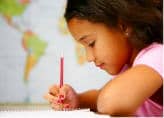
At K5 we advocate for “little and often” when it comes to learning. Spending 20-30 minutes per day with learning activities prepare young kids, not only for the study skills they’ll need later in their academic lives, but also by focusing on essential reading and math activities helps to build the foundation for later, more complex concepts. We often talk about how in grade 4 the focus on reading shifts from “learning to read” to “reading to learn”.
With that said, we thought we’d go through the four types of memory and what parents need to pay attention to in order to help their kids commit learned facts to their long-term memory.
Semantic Memory
Semantic memory is about rehearsal. It holds information learned from words, symbols and abstractions. There are two forms of rehearsal parents can think about for their kids – rote rehearsal, such as learning of math facts (K5 Math Facts focuses solely on this) and elaborate rehearsal, such as thinking about the meaning of a word, its purpose and how it relates to other things.
Episodic Memory
When we learn based on context and location, this is called episodic memory. Providing contextual clues to information helps kids to associate learned facts, such as the use of colors and symbols, pictures and animations. If a certain topic taught is printed on red paper or animals are used to show math concepts, this can help the student to delve into their episodic memory.
Sensory Memory
Like the word suggests, sensory memory is evoked through the senses, such as physical activity and role playing. Think about learning to ride a bike, sensory memory works in a similar way. Through repeated role playing, debates and group activities, kids initiate their sensory memory.
Reflective Memory
Emotionally driven, reflective memory is exactly what it sounds like – reflecting on things that trigger an emotion. For example, a parent that took a child out for a treat to celebrate a great math result, may make that child reflect back on that occurrence the next time they take a math test.
Now obviously I have simplified the memory categories and in separating them, this does not truly reflect how memory works, Most facts and concepts learned often involve many of these faculties at once, but in separating them it makes it easier to identify what memory triggers we all use and to come up with ideas on how we can help our kids in their learning.

